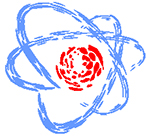Speaker
Ms
Klaudia Mencel
(Faculty of Chemistry, University of Wroclaw)
Description
There is a surge of interest in development of new, single- and two-components organic ferroelectrics materials suitable for electronic applications. Recent achievements in this field indicate, that these molecular ferroelectrics exhibit an excellent physical properties such as an extremely high value of the spontaneous polarization (Ps), a high Curie temperature (Tc), good thermal stability as well as optical transparency [1]. These polar materials are also very attractive because of their lightweight, price, easy preparation and low-toxicity for the environment. For these reasons, they are highly desirable and constantly improved.
Extensive search for new molecular ferroelectrics leads to a group of the halide derivatives of diisopropylammonium, abbreviated as DIPA. This family presents a practical interest due to its spectacular dielectric properties. Namely, DIPA bromide discovered simultaneously by two groups: Xiong R.–G. [2] and Jakubas R. [3], possesses the spontaneous polarization about 23 uC·cm-2 which is the highest among organic ferroelectrics and is comparable with classical inorganic ferroelectrics. The DIPA derivatives are, thus, attractive for further studies, and are potential candidates for superseding the lead-based toxic inorganic ferroelectrics which are widely used till now.
My oral presentation is focused on study another member of the family, i.e. DIPA iodide [4]. The results are surprising and greatly different from those for the remaining compounds. Although the dielectric response is typical for a ferroelectric phase transition, when approaching the unique phase transition from below, the spontaneously polarized phase does not occur. Instead, the system transforms into another phase of a symmetry that is not group-subgroup related to the initial phase. The most fundamental properties: crystallographic structure, thermodynamics, electric permittivity, second harmonic generation and the domain texture of the title compound are presented. To throw more light on the molecular mechanism of the phase transition, the infrared studies in a wide temperature range are also attached.
[1] S.-T. Han, Y. Zhou, V. A. L. Roy, Adv. Mater. 25, 5425-5449 (2013)
[2] D.-W. Fu, H.-L. Cai, Y. Liu, Q. Ye, W. Zhang, Y. Zhang, X.-Y. Chen, G. Giovannetii, M. Capone, J. Li, R.-G. Xiong, Science 339, 425-428 (2013)
[3] A. Piecha, A. Gągor, R. Jakubas, P. Szklarz, CrystEngComm 15, 940-944 (2013)
[4] A. Piecha-Bisiorek, A. Gągor, D. Isakov, P. Zieliński, M. Gałązka, R. Jakubas, Inorg. Chem. Front 4, 553–558 (2017)
Author
Ms
Klaudia Mencel
(Faculty of Chemistry, University of Wroclaw)
Co-authors
Dr
Anna Gagor
(W. Trzebiatowski Institute of Low Temperature and Structure Research PAS)
Dr
Anna Piecha-Bisiorek
(Faculty of Chemistry, University of Wroclaw)
Prof.
Jan Baran
(Institute of Low Temperature and Structure Research, PAS)
Dr
Piotr Durlak
(Faculty of Chemistry, University of Wroclaw)
Prof.
Piotr Zielinski
(The H. Niewodniczanski Institute of Nuclear Physics, PAS)
Prof.
Ryszard Jakubas
(Faculty of Chemistry, University of Wroclaw)

